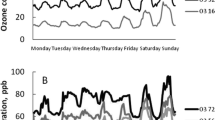Summary
The growth of potted birch cuttings (one clone of Betula pendula) was studied under low O3 concentrations (0, 0.050, 0.075, 0.100 μl l-1) throughout an entire growing season. With increasing O3 dose, 20–50% of all leaves formed were prematurely shed, while 40–70% of the remaining foliage displayed advanced discoloration by the end of the season. Ozonation affected the S, P and N concentration of leaves and increased δ13C in leaves and stem, while the CO2 assimilation rate declined with increasing CO2 concentration in mesophyll intercellulars. While whole-plant production correlated negatively with the O3 dose, ozone increased the specific leaf weight (i.e. leaf weight/leaf area, SLW) but decreased the ratios of stem weight/stem length and root/shoot biomass. Neither the latter ratio nor SLW changed in experimentally defoliated control plants, whereas in ozonated plants starch accumulated along leaf veins and phloem tissue was deformed in the leaf petioles and the stem. Only in early summer was the relative growth rate higher in the ozonated than in the control plants. The ratio of whole-plant biomass production versus total foliage area formed was lowered under O3 stress. However, when relating biomass to the actual foliage area present due to leaf loss, this ratio did not differ between treatments. Similarly the ratio of actual foliage area versus basal stem area in cross-section did not differ. Overall, whole-plant production was strongly determined by O3-caused changes in crown structure and began to be limited at O3 doses (approximately 180 μl l-1 h) similar to those of rural sites in Central Europe.
Similar content being viewed by others
References
Becker K, Saurer M, Egger A, Fuhrer J (1989) Sensitivity of white clover to ambient ozone in Switzerland. New Phytol 112: 235–243
Brenninkmeijer CAM (1983) Deuterium, oxygen-18 and carbon-C13 in tree rings and peat deposits in relation to climate. Doctoral thesis, University of Groningen
Craig H (1957) Isotopic standards for carbon and oxygen and correction factors for mass spectrometric analyses of carbon dioxide. Geochim Cosmochim Acta 12: 133–149
Ericsson A, Larsson S, Tneow O (1980) Effects of early and late season defoliation on growth and carbohydrate dynamics in Scots pine (Pinus sylvestris). J Appl Ecol 17: 747–770
Farquhar GD, Sharkey TD (1982) Stomatal conductance and photosynthesis. Annu Rev Plant Physiol 33: 317–345
Farquhar GD, Ehleringer JR, Hubick KT (1989) Carbon isotope discrimination and photosynthesis. Annu Rev Plant Physiol 40: 503–537
Fink S (1989) Microscopical aspects of foliar alterations in declining trees. In: Ulrich B (ed) International Congress on Forest Decline Research: state of knowledge and perspectives, Friedrichshafen. Friedrichshafen, Forschungsbeirat Waldschäden/Luftverunreinigungen der Bundesregierung und der Länder, pp 431–443
Gifford RM (1974) A comparison of potential photosynthesis, productivity and yield of plant species with differing photosynthetic metabolism. Aust J Plant Physiol 1: 107–117
Greitner CS, Winner WE (1988) Increases in δ13C values of radish and soybean plants caused by ozone. New Phytol 108: 489–494
Landolt W, Pfenninger I, Lüthy-Krause B (1989) The effect of ozone and season on the pool sizes of cyclitols in Scots pine (Pinus sylvestris). Trees 3: 85–88
Lange OL, Beyschlag W, Tenhunen JD (1987) Control of leaf carbon assimilation — input of chemical energy into ecosystems. In: Schulze E-D, Zwölfer H (eds) Ecological studies, vol 61. Springer, Berlin Heidelberg New York, pp 149–163
Lüthy-Krause B, Pfenninger I, Landolt W (1990) Effects of ozone on organic acids in needles of Norway spruce and Scots pine. Trees 4: 198–204
Martin B, Bytnerowicz A, Thorstenson YR (1988) Effects of air pollutants on the composition of stable carbon isotopes, δ13C, of leaves and wood, and on leaf injury. Plant Physiol 88: 218–223
Matyssek R, Schulze E-D (1987) Heterosis in hybrid larch (Larix decidua x leptolepis) II. Growth characteristics. Trees 1: 225–231
Matyssek R, Günthardt-Goerg MS, Keller T, Scheidegger C (1991) Impairment of gas exchange and structure in birch leaves (Betula pendula) caused by low ozone concentrations. Trees 5: 5–13
Michin PEH, Gould R (1986) Effect of SO2 on phloem loading. Plant Sci 43: 179–183
Mooney HA, Winner WE (1988) Carbon gain, allocation, and growth as affected by atmospheric pollutants. In: Schulte-Hostede S, Darral NM, Blank LW, Wellburn AR (eds) Air pollution and plant metabolism. Elsevier, London, pp 272–287
Mooney HA, Küppers M, Koch G, Gorham J, Chu C, Winner WE (1988) Compensating effects to growth of carbon partitioning changes in response to SO2-induced photosynthetic reduction in radish. Oecologia (Berl) 75: 502–506
Reich PB, Lassoie JP (1985) Influence of low concentrations of ozone on growth, biomass partitioning and leaf senescence in young hybrid plants. Environ Pollut 39: 39–51
Reich PB (1983) Effects of low concentrations of O3 on net photosynthesis, dark respiration, and chlorophyll contents in aging hybrid poplar leaves. Plant Physiol 73: 291–296
Reich PB (1987) Quantifying plant response to ozone: a unifying theory. Tree Physiol 3: 63–91
Schulze E-D, Chapin FS III (1987) Plant specialization to environments of different resource availability. In: Schulze E-D, Zwölfer H (eds) Ecological studies, vol 61. Springer, Berlin Heidelberg New York, pp 120–148
Spence DR, Rykiel EJ, Sharpe JR, Sharpe PJH (1990) Ozone alters carbon allocation in loblolly pine assessment with carbon-11 labeling. Environ Pollut 64: 93–106
Waring RH (1987) Characteristics of trees predisposed to die. Bioscience 37: 569–574
Winner WE, Gillespie C, Shen W-S, Mooney HA (1988) Stomatal responses to SO2 and O3. In: Schulte-Hostede S, Darral NM, Blank LW, Wellburn AR (eds) Air pollution and plant metabolism. Elsevier, London, pp 255–271
Author information
Authors and Affiliations
Rights and permissions
About this article
Cite this article
Matyssek, R., Günthardt-Goerg, M.S., Saurer, M. et al. Seasonal growth, δ13C in leaves and stem, and phloem structure of birch (Betula pendula) under low ozone concentrations. Trees 6, 69–76 (1992). https://doi.org/10.1007/BF00226583
Received:
Issue Date:
DOI: https://doi.org/10.1007/BF00226583




